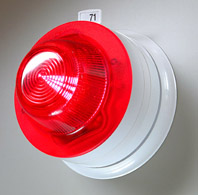|
Apollo's
Loop-Powered Beacon has been developed as a supplement to
sounders for use
in situations where there is a risk that sounders may not be heard.
These include:
where there is
high background noise
where the occupants are deaf or hard of hearing
It can also be used
in enviroments where a 'staff alarm' is preferable, for example in
hospitals, or where sounders are undesirable, such as in TV or radio
stations or in cinemas.
The beacon is
available in three colour variants:
red (part no. 55000-877)
amber (part no. 55000-879)
clear lens/red flash (part no. 55000-878)
Note: please allow 46 weeks for delivery of the
amber and clear lens/red flash beacons.
The
beacon:
is designed for indoor use
is lockable, like a detector
has a wide angle of visibility
is loop-powered
has a low current consumption - just 3mA
uses LEDs
complies with BS5839-1: 2002
is available in three colour variants |
 |
| |
Picture shows the loop-powered
beacon on an intelligent sounder base |
The beacon can be
connected to detection systems using XP95 or
Discovery detectors. However, the
features of the beacon are only available when it is connected to a
control panel with the appropriate software.
The beacon is fitted
to any XP95 or Discovery base and would normally be wall mounted.
Alternatively it can be used in combination with Apollo sounders. If the
beacon is fitted to an Apollo Ancillary Base Sounder, the sounder
will be controlled by the beacon; if it used with an
Intelligent Base
Sounder, the beacon is fitted to a mounting base which in
turn is fitted to the Intelligent Base Sounder. By doing this, the
devices can be controlled separately. The beacons can be synchronised
with each other and with Apollo sounders.
Up to 20 beacons may
be fitted between standard XP95 isolators or isolating bases. A loop
loading calcuation should be made in order to determine the exact number
in a loop. A loop calculation programme is available as a free download
from this site. Please click here for more details.
Click
here for product literature |